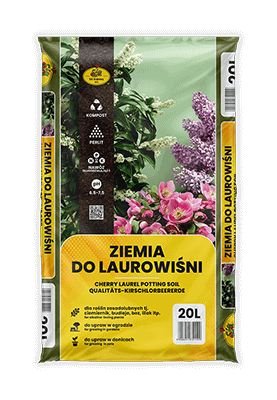



• Growing cherry laurel, buddleia, hellebore, boxwood, lilac, grapevine, garden pink.
• Growing plants in pots and gardens.
• Peat
• Green compost
• Composted bark
• Basalt sand
• Pearlite
• Long-acting NPK fertilizer
• Salinity: < 2,0 g/l
• Texture: 0-40mm
• Best time for repotting: It is recommended to perform repotting in spring or autumn. Repotting cherry laurel in early autumn gives the plant enough time for rooting before winter and regeneration during dormancy.
Product preparation
• The product is mechanically compressed, it is recommended to loosen it before use.
• The dry soil should be moistened with water.
Repotting into a larger pot
• Prepare a clean pot with drainage holes that is larger than the root ball.
• Gently remove the root ball and remove dead roots.
• Pour a layer of drainage, such as expanded clay, into the bottom of the pot.
• Place the plant at an adequate depth, fill the pot with soil to 2 cm below the edge and slightly compact the soil.
• Water the plant abundantly immediately after repotting.
Replanting to the ground
• Dig a hole that is approximately 30% bigger than the root ball.
• Partially fill the hole with our soil.
• Place the plant at an appropriate depth and fill the hole with substrate.
• We recommend starting fertilization 6–8 weeks after replanting.
Practical advice
• Cherry laurel prefers half-shaded and shaded sites. Long-term exposure of leaves to sunlight may result in scorching of the plant.
• It is advisable to cover the cherry laurel with garden bark mulch – it will ensure that the right level of moisture is retained in the soil, which promotes the proper development of the bush. A young plant may require regular watering, especially during periods of the greatest heat and drought.
• Cherry laurel is easy to shape, so you can shape it to your liking and match it to the nature of your garden. It is ideal for a hedge.